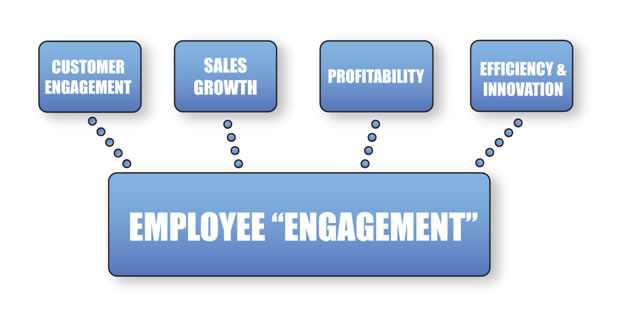|

According to the Gallup Management Journal's Employee Engagement Index 29% of employees are actively engaged in their jobs, 54% are not-engaged, and 17% are actively disengaged. The statistics on workforce engagement are surprising. Almost two third of the workers are either moderately engaged or not engaged, it is hard to ignore this wake up call.
Actively engaged employees: Today, employee engagement has become a growing management concern. Engaged workers make more money for the company. They contribute towards a healthy working environment. They stay with the organization longer and are more committed to quality and growth than are the other two groups of not-engaged and actively disengaged workers. Engaged employees usually need the least amount of attention from managers because they're doing what they are needed to do. The challenge for managers comes when the signs of disengaging appear from an engaged worker. The symptoms need to be addressed immediately. Great managers spend most of their time with the most productive and talented people because they have the most potential.
Employees are usually hired to do three things:
1. Achieve the business outcomes of their roles
2. Contribute to creating a productive workplace
3. Drive customer engagement
A Manager should spend ample amount of time with his subordinates. He should get the individual to view his or her role from a broader perspective instead of from a narrow task-oriented point of view. They can help employees clarify how they can achieve their outcomes. Measurement of outcomes also becomes crucial. Good measurement includes regular feedback, aligns with outcomes and matches the expectations for the role. An effective leaders help the people to design and own their own goals, targets and milestones. Great managers provide coaching to facilitate progress of their subordinates.
Not-engaged employees: A special mention here is required of the Not-engaged employees. These employees tend to concentrate on tasks rather than the goals. They want to be told what to do. They have no real aspirations of their own. These employees tend to feel that their contributions are being overlooked. As a result they hang back and do the minimum because they don't believe anyone cares. Effective managers take time out to have a dialogue about an employee's strengths and how these can make a difference, leading to employee commitment.
Actively disengaged employees: They act out their discontent and sow seeds of negativity at every opportunity. They are indifferent to company goals and mission. The Gallup Organization estimates that there are 22 million actively disengaged employees that cost the American economy up to $350 billion per year in lost productivity, including absence, illness and other problems that result when workers are unhappy at work. Good managers will identify those who are disengaged and explore the reasons behind the disconnect to determine interventions can be made use of. Those who are actively disengaged may refuse to become part of any solution.
What employees want?
Here is a summary of what workers responding to the a Gallup survey said they what they want from their managers;
� Focus me
� Know me
� Care about me
� Hear me
� Help me feel proud
� Help me review my contributions
� Equip me
� Help me see my value
� Help me grow
� Help me see my importance
� Help me build mutual trust
� Challenge me
And how do you do that?
� Provide feedback and guidance
� Make real time to discuss problems
� Seek ideas and input from everyone
� Provide the resources to solve problems or to do a job well
� Give real recognition and/or reward
� Provide opportunities for people to develop their potential
� Keep the pressure to perform and achieve more with less realistic
� Provide opportunities for social interaction
� Train people how to resolve interpersonal conflicts
� Promote joy and appropriate humor within the office
� Be flexible; help people to actively balance work and home responsibilities
|













